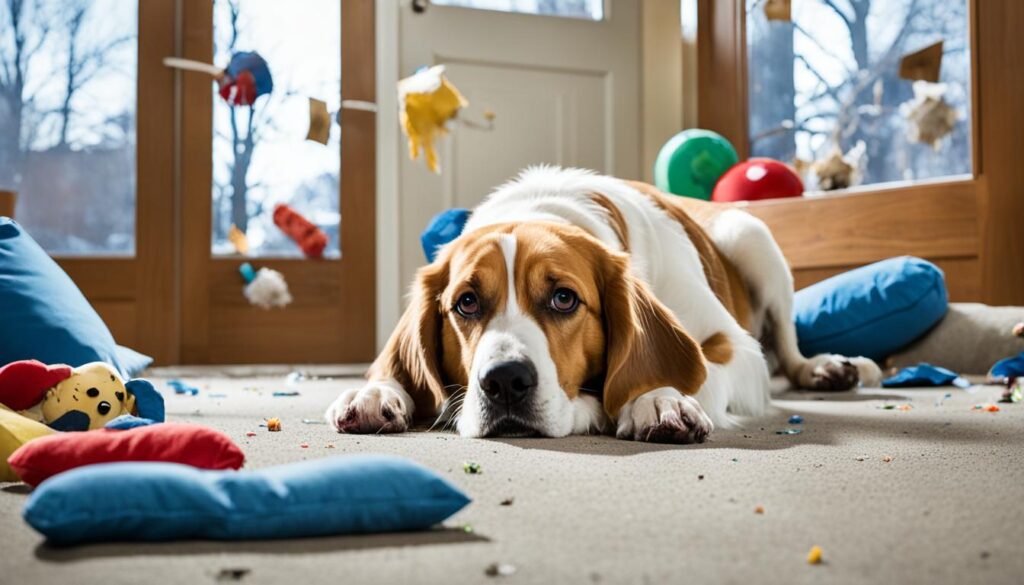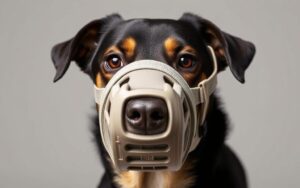
Did you know that up to 20% of dogs may suffer from separation anxiety?
Separation anxiety in dogs is a condition that affects a significant number of canine companions. When left alone, these dogs experience excessive fear and distress, leading to a range of behavioral issues. Understanding the causes, symptoms, and solutions for separation anxiety can help dog owners provide the support and care their furry friends need.
Key Takeaways: Separation Anxiety in Dogs
- Separation anxiety affects up to 20% of dogs.
- Dogs with separation anxiety exhibit distress and behavioral issues when left alone.
- Causes of separation anxiety may include changes in routine, moving homes, traumatic events, and more.
- Common symptoms of separation anxiety in dogs include trembling, destructive chewing, howling, and urination/defecation.
- Treating separation anxiety involves physical and mental exercise, establishing routines, and positive reinforcement training.
- Alming Aid Melatonin Dog Supplement..Helps Reduce Stress in Dogs
What is Separation Anxiety in Dogs?
Separation anxiety is a fear of being left alone and the unknown that follows. Dogs live in the present moment, so when their owners leave, they may fear that they won’t come back. This fear is distinct from generalized anxiety or boredom and is characterized by excessive distress and panicked behavior, such as tearing through crates, couches, or even walls.
This fear of being left alone can be a challenging issue for both dogs and their owners. It can lead to destructive behavior, excessive vocalization, and even self-harm. Recognizing the signs of separation anxiety is the first step in helping our furry friends find relief and regain their sense of security.
When a dog experiences separation anxiety, it can manifest in various ways. Some dogs may become visibly anxious, pacing around the house, whining, or barking excessively when their owner prepares to leave. Others may exhibit more destructive behavior, such as chewing objects or digging at doors and windows in an attempt to escape. These behaviors are not indicative of disobedience, but rather a response to the fear and distress associated with being separated from their trusted human companion.
“When my dog, Max, experiences separation anxiety, he starts barking and scratching at the door the moment I pick up my keys. He becomes extremely anxious and even breaks household items in an attempt to find comfort. It breaks my heart to see him like this.”
It’s important to note that separation anxiety can affect dogs of any age, breed, or background. It is not limited to rescue dogs or those who have experienced trauma in the past. The fear of being left alone can develop in any dog, regardless of their history.
Understanding the root causes of separation anxiety is crucial in addressing and managing this condition. In the next section, we will explore the various factors that contribute to the development of separation anxiety, helping us further comprehend this complex behavioral issue.
Causes of Separation Anxiety
Several factors can contribute to the development of separation anxiety in dogs. These include:
- Transitions or changes in routine: Dogs thrive on stability and predictability. Moving homes, being adopted after being in a shelter, or when family members return to work or school after a long period at home can disrupt their sense of security and trigger separation anxiety.
- Experiencing traumatic events: Dogs that have gone through traumatic experiences, such as abuse or neglect, may develop separation anxiety as a result of the emotional and psychological impact.
- Being housed in a shelter or boarding kennel: Dogs that have spent significant time in shelters or boarding kennels, where they have limited human interaction and routine changes, may develop separation anxiety due to the lack of stability and constant caregiver presence.
- Death of a family member or pet: The loss of a loved one, whether human or animal, can deeply affect dogs and lead to separation anxiety as they fear being left alone and worry about further losses.
These causes can have a profound impact on a dog’s mental and emotional well-being, resulting in the manifestation of separation anxiety when they are separated from their owners.
Symptoms of Separation Anxiety
Dogs with separation anxiety experience distress and display various behavioral issues when left alone. These symptoms are a result of the dog’s fear and anxiety about being separated from their owner. Understanding the signs of separation anxiety can help dog owners identify and address this condition.
Common symptoms of separation anxiety in dogs include:
- Trembling: Dogs may tremble or shake uncontrollably when left alone.
- Salivating: Excessive drooling is often observed with separation anxiety.
- Destructive Chewing: Dogs may engage in destructive chewing behavior, targeting furniture, shoes, or other items in the home.
- Howling and Barking: Excessive vocalization, such as howling or barking, is a common symptom of separation anxiety.
- Urination and Defecation: Dogs may inappropriately urinate or defecate indoors, regardless of their house-training status.
These symptoms can occur even if the dog has never displayed such behaviors in the past. It’s important to note that these behaviors are a manifestation of the dog’s distress and should not be attributed to spite or disobedience.
If you notice these symptoms in your dog, it’s essential to consult with a veterinarian or a professional dog trainer who specializes in separation anxiety. They can provide guidance and create a tailored treatment plan to address your dog’s specific needs.
Treating Separation Anxiety in Dogs
When it comes to treating separation anxiety, a multi-faceted approach is key. By combining various strategies, you can help alleviate your furry friend’s anxiety and create a more peaceful environment for both of you.
Physical Exercise
Physical exercise is an essential component of separation anxiety treatment. Taking your dog on long walks and engaging them in activities such as playing fetch or running can help tire them out and reduce anxiety. A tired dog is often a calmer and more relaxed dog, making it easier for them to cope with being alone.
Mental Exercise
Just like humans, dogs need mental stimulation to keep them engaged and distracted from their anxiety. Providing puzzle toys and enrichment activities can engage their minds and keep them occupied while you’re away. These activities can help redirect their focus from their fear and prevent them from engaging in destructive behaviors.
Establishing a Routine
A predictable routine can provide a sense of security for dogs with separation anxiety. Try to establish a consistent daily schedule for your dog, including feeding times, exercise sessions, and alone time. Keeping the routine relaxed and predictable can help your dog feel more at ease and reduce anxiety.
Creating a Safe Space
Creating a safe space for your dog is crucial in managing separation anxiety. Dedicate a specific area in your home where your dog feels safe and secure. Fill the space with their favorite toys, blankets, and familiar smells to create a comforting environment. This safe space can provide them with a sense of calm and security when you’re not around.
Playing Soothing Music
Music has a powerful effect on our emotions, and the same goes for dogs. Playing soothing music specifically designed for dogs can help create a calming atmosphere and reduce anxiety. There are even playlists available that are scientifically curated to help dogs relax and feel more at ease in stressful situations.
Consider Anti-Anxiety Medication
In severe cases of separation anxiety, your veterinarian may prescribe anti-anxiety medication for your dog. These medications can help reduce their anxiety baseline and make it easier for them to cope with being alone. It’s essential to work closely with your vet to determine the right medication and dosage for your dog.
Positive Reinforcement Training
Positive reinforcement training, with the assistance of a professional dog trainer, can be incredibly beneficial in treating separation anxiety. This type of training focuses on desensitizing your dog to triggers and reinforcing calm behavior. Through positive reinforcement techniques, you can help your dog associate being alone with positive experiences, gradually reducing their anxiety over time.
By implementing these strategies and tailoring them to suit your dog’s individual needs, you can make significant progress in treating separation anxiety. Remember, each dog is unique, and what works for one may not work for another. It’s important to be patient, consistent, and seek professional guidance when needed.
Preventing and Managing Separation Anxiety in Dogs
Preventing separation anxiety is crucial for their overall well-being and your peace of mind. By implementing proper socialization and training techniques from a young age, you can help your furry friend develop coping mechanisms and minimize the risk of separation anxiety.
Socialization: Introduce your puppy to various environments, including different animals, people, and places. This exposure will help them feel comfortable and confident when faced with new situations, reducing their anxiety levels in the long run.
Alone Time: Teach your dog to spend time alone gradually. Start with short periods and gradually increase the duration as they become more comfortable. Provide toys and interactive puzzles to keep them engaged and entertained during their alone time.
Enrichment: Keep your dog mentally and physically stimulated through daily enrichment activities. This can include puzzle toys, obedience training, agility exercises, or interactive play sessions. A tired and satisfied dog is less likely to develop anxiety-related behaviors.
Predictable Routine: Dogs thrive on routine and predictability. Establish a consistent daily schedule for feeding, exercise, playtime, and rest. Knowing what to expect will give your dog a sense of security, reducing the likelihood of separation anxiety.
Rewards and Positive Reinforcement: Use rewards and positive reinforcement techniques to reinforce desired behaviors and create positive associations with being alone. When your dog settles and relaxes on cue, reward them with praise, treats, or interactive play. This will help them associate their alone time with positive experiences.
Settle and Relaxation Training: Train your dog to settle and relax on command. This can be done through exercises such as “capturing calm,” where you reward and reinforce calm behavior. You can also use relaxation techniques such as gentle massage or playing soothing music to create a calming environment.
“Preventing separation anxiety in dogs is all about building a strong foundation of confidence, socialization, and positive experiences. By providing a secure and enriching environment, you can help your furry friend feel more comfortable when left alone.”
Conclusion: Separation Anxiety in Dogs
Separation anxiety can be a challenging condition to manage, requiring patience, compassion, and consistency. The treatment duration for separation anxiety varies from dog to dog, and it can take several months to see significant improvements. While many dogs can go on to live stress-free lives, it’s important to note that symptoms may resurface during times of transition or change.
It’s crucial to recognize that each dog is unique and may have individual needs that require more time, energy, or resources than their owner can provide. In such cases, exploring rehoming options with the assistance of local shelters or rescues can ensure the dog’s well-being and happiness in a more suitable environment. Rehoming should be considered as a thoughtful decision made in the best interest of the dog and their specific needs.
If you’re facing challenges with a dog experiencing separation anxiety, remember to seek professional guidance and support. With proper treatment, understanding, and tailored care, many dogs can overcome separation anxiety and lead fulfilling lives.











